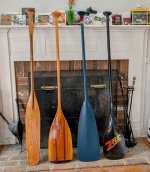What characterizes a “Cue” paddle?
Simply, Pat Moore called
his paddles "cues". Canoe paddles other than his were "primitive", so his deserved a special name. He custom designed each one so it could control a "sport canoe" with the precision and accuracy of Fast Eddie's pool cue.
More wordily, I will quote from Patrick Moore's erudite "Sport Canoeing Skills Philosophy", which was published on his now defunct website:
"Defining the Equipment
"Sport Canoeing requires only two items of equipment: a cue and a canoe.
Each of these is a huge subject in and of itself, and we will post volumes of
information about them on this Web site. Immediately, we will only look at
this equipment in general terms, based on what we've already discussed
about Sport Canoeing's purpose, possible motions and technique.
"The Cue
"The cue, or its more primitive form, the canoe paddle, is the primary piece of
equipment. This is often counter-intuitive to beginners because the canoe is
so much bigger—and you actually get inside of it. Ask any expert, however,
and he will immediately agree that the canoe paddle is more important than
the canoe. Of course, a canoe is essential, but its shape and proportions are
defined by your purpose and your technique. And you will notice that nearly
everything in our discussion of technique, above, referred to how you handle
the cue.
"For an example of the subordination of equipment to technique and of the
canoe to the paddle, imagine that your purpose for canoeing is simply to
travel. Also suppose that you also want to invest as little time as possible in
learning new skills, so you decide that the steering technique you use will be
to simply switch sides every few strokes. Then you observe that you can
maintain a straighter course if you switch sides after every stroke. You realize
that it would be less cumbersome to execute this technique if only you had
one blade dedicated to each side of your canoe—so you invent a doublebladed
paddle. Sitting high on your canoe seat, you find yourself flailing the
air with the recovering blade on your long double-bladed paddle, and realize
that for every inch closer to the water that you sit, you can make your
double-bladed paddle two inches shorter. So you sit on the bottom of your
canoe and shorten the paddle to a manageable length. The problem now,
however, is that you keep banging your elbows on the gunwales! You resolve
that the solution is to make the sides of the canoe lower in order to keep the
gunwales out of your way so you can more easily reach the water. But that
creates yet another problem—with the sides so low, your canoe has become
very unseaworthy, and water keeps splashing in. To solve this final problem,
you put a deck on your canoe. What do you have? A kayak. Kayaks are not
propelled with double-bladed paddles by some whimsical choice—they were
designed (consciously or not) for double-bladed paddles. This is a good
schematic example of how purpose determines technique, which determines
the paddle design, which determines the boat design. You can't rightly shuffle
that deck.
"Returning to the Sport Canoeing cue and keeping in mind everything we
learned earlier, the cue must be sized and proportioned to match the size and
proportions of your body, and designed to use your musculature and the
natural lever systems of your body to greatest benefit. Your interface with it
—its grips—must have shapes and textures that are natural, comfortable and
sure. The blade must be sized and proportioned to anchor firmly in the water,
yet be thin enough and properly profiled to slice effortlessly through the
water during wet recoveries. It must be straight and perfectly symmetrical so
that you can use either the natural or reverse faces indiscriminately, with
predictably identical results. It must be light and well-balanced. Together,
these features will make a cue seem so much a natural part of you that you
will often be unaware that you even hold it in your hands.
"With such a cue in your hands, any canoe can be made to perform well. To
execute all of the techniques discussed earlier, however, a sport canoe must
have a few special qualities."
Patrick then tells us what a "sport canoe" is, but that's a different topic.

